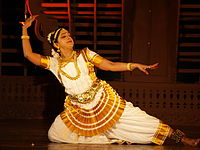- Indian classical dance
-
]] Indian classical dance is a relatively new umbrella term for various codified art forms rooted in Natya, the sacred Hindu musical theatre styles, whose theory can be traced back to the Natya Shastra of Bharata Muni (400 BC).
Contents
Definitions
 Prakriti Ora, one of the sixty four mati-akhora or basic Sattriya exercises.
Prakriti Ora, one of the sixty four mati-akhora or basic Sattriya exercises.
These are:
- Dances performed inside the sanctum of the temple according to the rituals were called Agama Nartanam. Natya Shastra classifies this type of dance form as margi, or the soul-liberating dance, unlike the desi (purely entertaining) forms.
- Dances performed in royal courts to the accompaniment of classical music were called Carnatakam. This was an intellectual art form. * Darbari Aattam form
For lack of any better equivalents in the European culture, the British colonial authorities called any performing art forms found in India as "Indian dance". Even though the art of Natya includes nritta, or dance proper, Natya has never been limited to dancing and includes singing, abhinaya (mime acting). These features are common to all the Indian classical styles. In the margi form Nritta is composed of karanas, while the desi nritta consists mainly of adavus.
The term "classical" (Sanscr. "Shastriya") was introduced by Sangeet Natak Akademi to denote the Natya Shastra-based performing art styles. A very important feature of Indian classical dances is the use of the mudra or hand gestures by the artists as a short-hand sign language to narrate a story and to demonstrate certain concepts such as objects, weather, nature and emotion. Many classical dances include facial expressions as an integral part of the dance form.
Dance forms
Sangeet Natak Akademi currently confers classical status on nine Indian dance styles (see table below), while the Encyclopædia Britannica mentions six recognized schools[1] and other sources state there are eight dance forms.[2][3]
Dance form State(s) of origin Bharatanatyam Tamil Nadu Gaudiya Nritya West Bengal Kathak Uttar Pradesh Kathakali Kerala Kuchipudi Andhra Pradesh Manipuri Manipur Mohiniyattam Kerala Odissi Orissa Sattriya Assam A dance style is classical to the extent it incorporates the Natya Shastra techniques. Some of the styles such as Kathak use very few elements found in Natya Shastra. Other art dances yet to be conferred as classical dances, whose theories and techniques can also be traced back to the Natya Shastra[citation needed] are:
- Andhra Natyam - Telugu art dance
- Vilasini Nrityam/Natyam - Telugu art dance
- Kerala Natanam - Kerala classical dance
Out of the nine recognized dance forms, the only two temple dance styles that have their origin in Natya Shastra and are prescribed by the Agamas are Bharata Natyam and Odissi. These two most faithfully adhere to the Natya Shastra but currently do not include Vaachikaabhinaya (dialog acts), although some styles of Bharata Natyam, such as Melattur style, prescribe the lip and eye movements indicating Vaachikaabhinaya.
Kuchipudi, which also prescribes the lip movements indicating Vaachikaabhinaya, and Mohiniyattam are relatively recent Darbari Aatam forms, just as Kathakali, and two eastern Indian styles, Manipuri and Sattriya, that are quite similar.
Kathak originated as a court dance. Some believe it evolved from Lord Krishna's raas lilas, forms of which have also evolved into the popular Garba-style dances popular in North India and Gujarat. The style gradually changed during the Mughal period under the influence of Persian dance, a major change being straight knees instead of the bent knees used in most other Indian classical forms. Intricate footwork and spins, as well as abhinaya, are the highlights of Kathak.
Currently, Sangeet Natak Akademi does not consider the recently reconstructed dance styles of Andhra Pradesh such as Andhra Natyam and Vilasini Natyam as "classical." Bharatanrithyam, despite being the one most closely following Natya Shastra's precepts, is considered as a variety of Bharata Natyam...
Sabha
Sabhas are the organizations involved in the promotion of classical art forms in South India. Ganamukundhapriya is one such Sabha that specialises in classical dances.
See also
Category:Dances of India
References
- ^ Encyclopædia Britannica. dance (performing arts) : Indian classical dance. Retrieved 03-11-2010.
- ^ "Indian Classical Dance". One India. 2009-04-19. http://living.oneindia.in/expressions/factual-expressions/indian-classical-dance.html. Retrieved 2010-06-11.
- ^ Narayan, Shovana (2005). Indian classical dances: "ekam sat vipraah bahudaa vadanti". Shubhi Publications. pp. 5. http://books.google.com/books?id=vxBq4xq94ZYC.
- Ambrose, Kay (1984). Classical Dances and Costumes of India. Palgrave Macmillan.
- Andhra Pradesh Portal: Dance. Andhra Pradesh Government. http://www.portal.ap.gov.in/Pages/Dance.aspx. Retrieved 2010-11-03.
Further reading
- Massey, Reginald (2004). India's dances: their history, technique, and repertoire. Abhinav Publications. http://books.google.co.uk/books?id=Lif-Ct05aVgC.
External links
Indian classical dance Bharata Natyam • Gaudiya Nritya • Kathak • Kathakali • Kuchipudi • Manipuri • Mohiniyattam • Odissi • SattriyaCategories:- Classical dance genres of India
- Sacred dance
Wikimedia Foundation. 2010.








